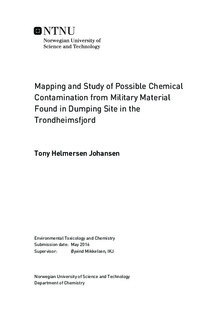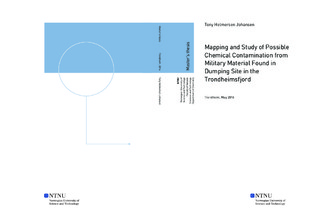| dc.description.abstract | This thesis has revolved around a dumping site at approximately 600 m depth in the Trondheimsfjord containing military material from the Second World War. Both water and sediment samples have been taken in and around the dumping site, where the main objective has been looking for metal(loid) contamination and the presence of organic explosives. Certain elements in the periodic table are toxic to aquatic organisms, and are therefore unwanted in the aquatic environment. Lead, mercury, and partly cadmium are the three main non-essential metals known, but copper is also very dangerous to aquatic organisms. A heightened presence of either one of these metals is therefore undesirable in the aquatic environment.
Acid digestion using nitric acid (HNO3) and UltraCLAVE have been used with Inductively Coupled Plasma Mass Spectrometry (ICP-MS) to find the element concentrations in the samples. Liquid Chromatography tandem Mass Spectrometry (LC-MS/MS) and Gas Chromatography Mass Spectrometry (GC-MS) have been used to look for the organic explosives 2,4,6-trinitrotoluene (TNT) and 1,3,5-trinitro-1,3,5-triazacyclohexane (Research Department Explosive, RDX).
The water samples have been found to contain relatively high concentrations of both copper (0.805 µg/L) and zinc (61.9 µg/L) in the surface water, which decreases to acceptable levels for copper after 50 m (0.439 µg/L). Copper is also found at harmful concentrations (> 55 µg/g) in several sediment samples according to a guideline created by the former Climate and Pollution Agency. This guideline uses total element concentrations, meaning the bioavailable concentration is not known. Potential adverse effects on organisms in the area can therefore not be confirmed based on the guideline values alone.
No TNT or RDX have been found in the sediment samples tested, indicating no noticeable spreading from the dumping site. TNT and RDX have not been looked for inside the dumping site, making the state of the military material unknown. However, no major iron enrichment has been observed in the water column or the sediment which is believed to indicate the explosive ammunition might still be intact.
The lack of biological data makes the potential danger of the copper and zinc concentrations difficult to assess. Monitoring the dumping site by taking several water and sediment samples per year both inside and around it is thought to be the best course of action. Biological studies are also thought to be a good way of determining the potential danger posed by toxic elements found in the area. | |

